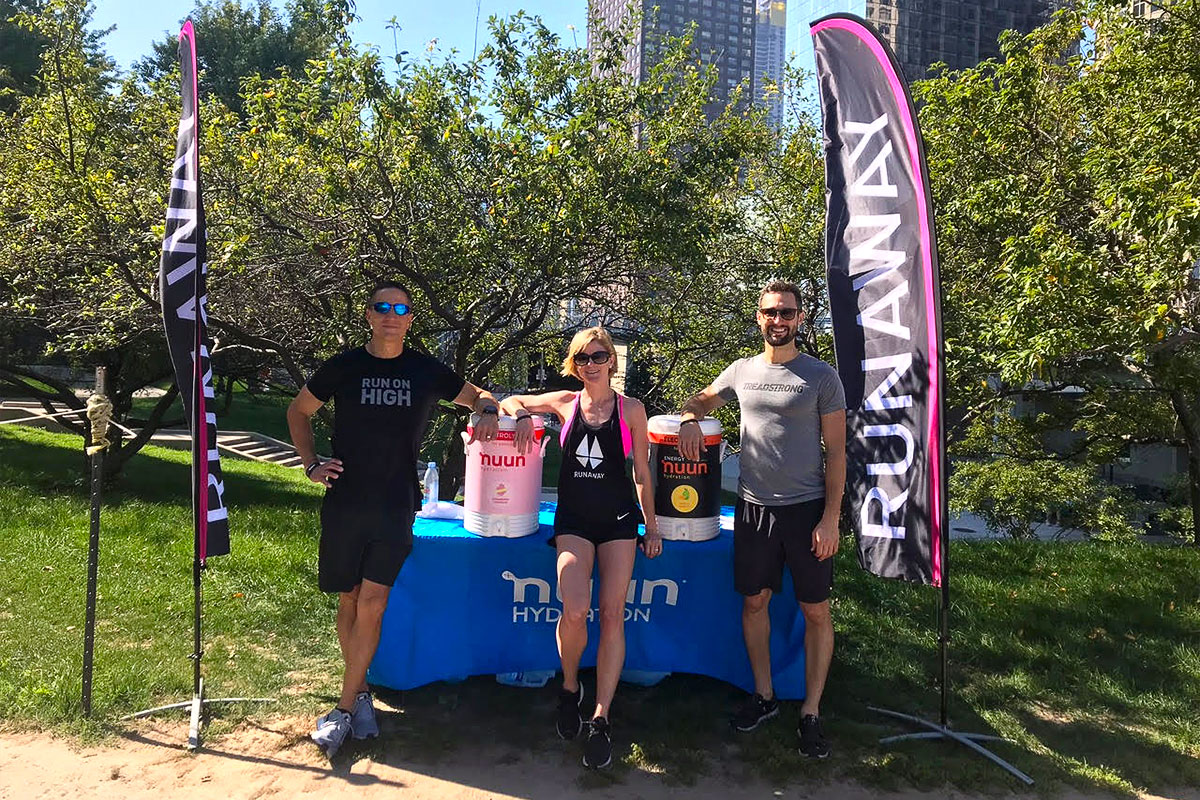When the new treadmill studio Runaway Fitness opens at 228 East Illinois Street later this fall, a few obvious features will set it apart from other boutique spaces.
For one thing, there’s the lighting, which will change colors to shift your mood and energy — amber to prime you pre-workout, intense red as you push hard, violet to calm you during the post-run cooldown. Motivating intentions will be inscribed into each locker (one preview: “Getting better is a campaign of discipline”).
And then there are the pace cards outlining the speeds you should aim for based on your experience level. They’re built into the dashboards of each of the 20 top-of-the-line Woodway treadmills, custom-designed to accelerate and decelerate rapidly.
These details aim to make your workout — classes that involve a mix of running and strength-training — fun and motivating. But it’s what you won’t see, an underlying principle called Adaptive Musculoskeletal Periodization or AMP, that might make the most difference in your results.
Essentially, classes at Runaway will build in intensity for three weeks, then feature a one-week “reset.” Month to month, the main focus alternates between strength and endurance. This structure not only boosts results, it also reduces the risk of injury and burnout, says founder and marathoner Kristine Theodore.
“All boutique fitness studios provide amazing workouts … but if you keep going to studios, it’s a string of singular workouts over and over again,” said Kai Karlstrom, Runaway’s director of operations, a triathlete who competed for Team USA in the 2013 World Championships, and a former trainer-of-trainers at Equinox. “From doing personal training, from working with clients and from being elite athletes, we know that you have to be on a structured, progressive program in order to obtain the results you’re looking for.”
Incorporating that type of buildup into group fitness posed a challenge for Karlstrom, Theodore, and Runaway’s other core team member (and Kristine’s husband) Ted Theodore. How could they take runners at different levels, and with different goals and schedules, and keep them moving forward without wearing out or breaking down?
AMP — which Karlstrom sketched as a series of flowchart-like blocks and arrows on a sheet of notebook paper — represented the solution. Each of the studio’s four classes will have a different feel; for instance, the signature Treadstrong splits time equally between treadmills and weight training, while Push+ involves 45 to 50 minutes of nonstop running and an added booster, such as form drills or core training.
But no matter which class or classes you choose in a given week, variables like the high-intensity intervals, inclines, and rest periods will be calibrated to move you toward that month’s goal of either strength or endurance. And thanks to the pace cards, each can be tailored to any runner’s or walker’s abilities.
This doesn’t mean you have to start on a specific date: “You can come in at any level of fitness and at any point in the month,” says Kristine Theodore. If you stick around, though, you’ll see a progression. “On a macro level, or month to month, you will feel the program evolve as you are becoming a better and stronger runner.”
While it might not be familiar to many group-fitness regulars, periodization is a standard component of high-level athletic training and an established concept in exercise science, says Michelle Adams, MS, an instructor in kinesiology and nutrition at UIC who spent 14 years in the fitness and wellness industry before joining academia. She defines periodization as “structured and organized variation.”
“The more you keep doing the same thing, the worse your results become, because you get bored, your body gets exhausted and you just can’t keep going anymore,” she says.
In other words, if you push yourself to the max in the same way every day or week, you’ll eventually start to plateau. Mixing things up randomly, based on how you’re feeling on a given day, can keep you out of a rut mentally. But, it might not result in optimal results physically.
Periodization allows you to work hard toward a goal, but thoughtfully plan breaks and changes to your routine. That way, your body has a chance to absorb all your hard efforts. When you ramp back up again, you can start building from a whole new level of speed or strength, Adams says.
At Runaway, all this is built in for you. But until the studio opens its doors — or if you already have a gym or activity you love — you can take steps to build periodization into your own routine, Adams says.
First, ask yourself how long you’ve been sweating in pretty much the same way. If it’s been six weeks or more, it’s probably time to change something up, especially if you’ve noticed a drop-off in your results despite the same level of effort.
The easiest change is to try a different type of movement for a week or so — hop on a bike for your intervals instead of a treadmill, or lift with free weights instead of machines or cables. But you can also manipulate some of the other variables, such as the length of your workouts, how often you do them, or how intensely you’re pushing within each one.
For more guidance, consult a personal trainer or look to online resources — such as the American Council on Exercise — for details on how to set up a periodized program for strength training, cycling, running, yoga, or any other activity, Adams recommends.




